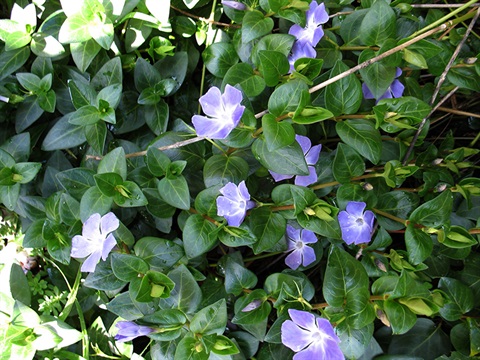Blue Periwinkle

Vinca major
Origin: South Europe and Noth Africa
Size: Trailing ground cover
Best removal time: Oct—Jan
Flowers: May—Jan
What it does
Blue Periwinkle invades damp to wet areas. It prefers shade but grows in full sun provided conditions are moist the majority of the time. It can completely dominate the understorey.
What it looks like
Leaves are a broad oval shape 4-8cm long and 1-5cm wide and are opposite each other on the stems and at right angles to those above and below. They are usually a shiny dark green on the top and paler green underneath, and can sometimes be variegated. Flowers are 3-5cm across and have 5 lilac-blue petals, flowering from winter to summer. Stems can grow up to a metre in length.
How it spreads
This plant mainly spreads vegetatively (from an extensive root system). Stems growing up and arch over, taking root as they touch the soil. Leaf nodes will also take root. The plant eventually forms a dense mat that smothers native vegetation and then prevents any new native plants from growing. There is little or no seed dispersed.
Plants are spread through the dumping of plants or soil containing parts of stems or roots. It is sold through nurseries, markets and fetes. Buyer beware!
Removal
By hand
Small infestations can be forked which is best done when the soil is moist, usually following rain. Ensure that all roots and stems are removed otherwise the plant will continue to grow. Dispose of the plant material carefully as it spreads very easily.
Spray with herbicide
Generally plants should be in an active growing stage and not be under any stress. Slashing the area in winter— early spring and then spraying the regrowth can increase the chance of success and reduce the amount of chemical required. Adding surfactants may improve the effectiveness of some herbicides. Many herbicides can only be applied by a registered chemical user, ring the Department of Energy, Environment and Climate Action on 136 186 for full details.
Indigenous alternatives to plant
Many plant alternatives exist that are indigenous to the Yarra Ranges region and would make great substitutes for this weed species. Some alternatives include:
How to dispose of weeds
By disposing of environmental weeds correctly you can prevent re-infestation on your property and elsewhere.
- Landfill (Weed Wipeout Tip vouchers available for some species).
- Green waste bins ensure that weeds are not able to spread.
- Woody weed stems can be bundled for green collection twice per annum.
- Composting (excluding seed heads or species with vegetative reproduction, e.g. Wandering Trad).
- Burning in accordance with Council and the Country Fire Authority (CFA) prescribed burning periods and regulations.
- Recovery and transfer stations available for weed tipping are Healesville, Wesburn, Coldstream, Lysterfield and Montrose.
Using chemicals
Non chemical treatment is often the most effective and safe option especially on smaller scale infestations.
Where chemical use is undertaken:
- Always follow the manufacturer’s guidelines when using chemicals.
- Wear protective clothing and eyewear.
- When purchasing your herbicide, always ask for a Materials Safety Data Sheet (MSDS) or refer to the manufacturer’s website for specific safety guidelines and information.
- Some herbicides will kill other plants and not just the target species.
- When used near waterways herbicides can be very poisonous to aquatic life.
- Use chemicals sparingly and be sure that you are using the right chemical and application technique.
- Ensure the weather conditions are suitable (e.g. minimal wind and no rain expected).
- Apply herbicides at the correct time during the plant’s growth cycle so you get the best results.